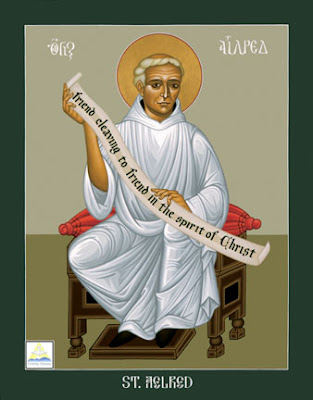Aelredo di Rievaulx: the Gay Holy of Friendship
Article of Kitretredge Cherry published on his blog Jesus in Love (United States) on January 12, 2016, freely translated by Silvia Lanzi
Aelredo di Rievaulx (1109-1167) is considered one of the most lovable saints, the patron saint of friendship and also, say some, a gay saint. His party is January 12th. Aelredo was abbot of the Cistercian Abbey of Rievaulx in England. His treatise "spiritual friendship" is still one of the best theological texts on the connection between human love and spiritual love. "God is friendship ... who dwells in the friendship lived in God, and God in Him"He writes paraphrasing 1 John 4:16.
 Aelredo's profound friendship with men was described in Christianity, Social Tolerance, and Homosexuality From John Boswell Professor of History of Yale. "There may be the small question that Aelredo was gay and his erotic attraction towards other men was a dominant force in his life, "Boswell writes.
Aelredo's profound friendship with men was described in Christianity, Social Tolerance, and Homosexuality From John Boswell Professor of History of Yale. "There may be the small question that Aelredo was gay and his erotic attraction towards other men was a dominant force in his life, "Boswell writes.
Boswell's narrative inspired the members of the LGBT Interrity episcopal group to appoint Aelredo as their patron saint. Click here for the entire story of how a gay saint was recognized.
Aelredo certainly supported the cause of chastity, but his passion is clear in his writings. He describes the friendship with eloquence in the passage, often mentioned, by his treatise "spiritual friendship":
"It is not a small consolation in this life, to have someone to join with intimate affection and the embrace of a holy love, someone in which your spirit can rest, in which you can pour your soul, thanks to whose pleasant exchanges, such as relaxing melodies, can be flying in pain ... with whose spiritual kisses, such as healing ointments, you can bring out all the tiredness of one's restless anxieties.
A man who can pour tears in worries with you, who can be happy when things are fine, who can seek with you the answers to your problems, which, with the ties of charity, you can bring deep of your heart ... where the sweetness of the spirit flows between you, where you will reach yourself and you will join so much to him that the soul will confuse with the soul and the two will be only. "
Aelredo encourages the friendship between the monks, comparing them, in his treatise on spiritual friendship to the love between Jesus and his disciple so loved and between Gionata and Davide. Louis Crompton, professor of English at the University of Nebraska, tells in Homosexuality and civilization That Aelredo allowed the monks of his Yorkshire monastery to express their affection holding hands, a practice discouraged by the other abbots.
Aelredo's writings were discussed widely in the 2015 book of an important evangelical scholar of the movement for the celibacy of LGBT Christians. Wesley Hill writes about friendship as a spiritual path, offering practical examples to build stronger friendships in Spiritual Friendship: Finding Love in the Church As a Gay Celibate Christian. "
The icon of Sant'Aelredo at the beginning of this post was painted by Robert Lentz, a Franciscan friar and a world -renowned iconographer known for his innovative icons. He also had to face disputes because, sometimes, his icons portray same sex couples. His image of Aelredo includes a kind of cartouche with his words, "The friend combined with his friend in the Spirit of Christ."
 [...] Another portrait of Aelredo was made doting his life. Aelredo is sitting in an alphabet minted in the medieval manuscript of the "De Speculo Caritatis", "The mirror of charity" (dated about 1140)
[...] Another portrait of Aelredo was made doting his life. Aelredo is sitting in an alphabet minted in the medieval manuscript of the "De Speculo Caritatis", "The mirror of charity" (dated about 1140)
The theologian Queer Hugo Cordova Quero writes about Aelredo in his article "Friendship with benefits: a queer reading of aelred of rievaulx and his theology of friendship”, Included in"The Sexual Theologian: Essays on sex, God and politics, " published by Marceus Althaus-Reid and Lisa Isherwood.
Quero cites and analyzes Aelredo's words "The mirror of charity"On the death of his first best friend, a monk companion named Simon:"I afflict myself for my beloved, for the one who was a single heart with me .."." And he continues to explore Aelredo's subsequent love for an anonymous monk, highlighting his attachment to men in the historical context and in a queer perspective. [...]
.






